Abstract
Red and confused flour beetles attack stored grain products such as flour, cereals, meal, crackers, beans, spices, pasta, cake mix, dried pet food, dried flowers, chocolate, nuts, seeds, and even dried museum specimens (Via 1999, Weston and Rattlingourd 2000). These beetles have chewing mouthparts, but do not bite or sting. The red flour beetle may elicit an allergic response (Alanko et al. 2000), but is not known to spread disease and does not feed on or damage the structure of a home or furniture. These beetles are two of the most important pests of stored products in the home and grocery stores. The confused flour beetle apparently received this name due to confusion over about its identity as it is so similar to the red flour beetle at first glance (Walter). This document is EENY-289 (IN566), one of a series of Featured Creatures from the Entomology and Nematology Department, Florida Cooperative Extension Service, Institute of Food and Agricultural Sciences, University of Florida. Published: June 2003. Revised: January 2004.
Unless otherwise specified, articles published in the EDIS journal after January 1, 2024 are licensed under a Creative Commons Attribution-NonCommercial-NoDerivs 4.0 International (CC BY-NC-ND 4.0) license.

